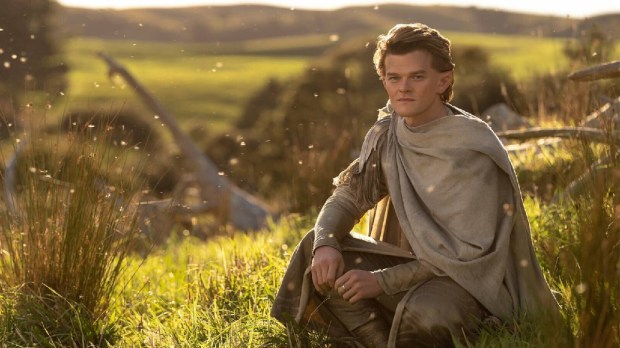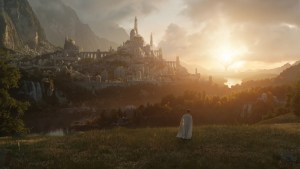First, my qualifications. I have read The Hobbit and The Lord of The Rings multiple times, but have finished The Silmarillion only once, ignoring most of the supplemental material. I’ve lost count of the times I’ve watched Peter Jackson’s Lord of the Rings movies, but have granted his Hobbit films only a few scant viewings. I own copies of Bakshi’s Lord of the Rings and the Rankin/Bass Hobbit TV adaptation and can hum a few bars of “The Greatest Adventure” if asked, but I can’t speak a lick of Elvish. Basically, while I have more than a passing familiarity with the world of Tolkien, the true fanatic would likely consider me a hopeless Philistine unworthy of speaking on such lofty matters.
All of that is to add a bit of context when I say that the first two episodes of Amazon’s new series, Lord of the Rings: The Rings of Power, are (so far) a promising addition to the annals of Middle Earth. Set thousands of years before the events of The Hobbit, the show attempts to, shall we say, fill in some of the gaps left in Tolkien’s writings, while staying mostly faithful to what he did put down in books and notes about this time period. I stress “mostly faithful.” To that end, it’s best to get some of the oliphaunts in the room out of the way before proceeding further.
When the show’s trailer was released, much ado was made of the decision to include people of color in the cast, not necessarily for racist reasons, but simply because it wasn’t accurate to Tolkien or the Norse culture which inspired much of his worldbuilding. The series handles the addition in the most graceful, unobtrusive way possible, which is to say it doesn’t mention it at all, allowing the non-white characters to exist. The only racial issues on display are the virulent anti-elf sentiments held by almost every non-elf character in the show. To be fair, though, those pointy-eared snobs do kind of ask for it.
More troubling to some purists might be the portrayal of Galadriel. While Tolkien unmistakably intended the older, stately “Lady of Light” to be reminiscent of Mary, Queen of Heaven, his take on the younger Galadriel is debatable. There are inconclusive passages indicating she may or may not have directly participated in military actions in some function and may or may not have been a commander. The series decides to err on the side of current tastes and depicts Galadriel as a rebellious young warrior-princess who leads others into battle using wire-assisted acrobatics that would put even Legolas to shame. It is what it is. Fortunately, from a storytelling point of view, her rebelliousness is driven not by slights to her gender, but something much more personal, revenge. And this is where the show begins.
The context of the series
A prologue very reminiscent of Peter Jackson’s movies gives a brief history of Middle Earth’s struggle against Morgoth (the devil, basically) and his chief lieutenant Sauron. Thanks to Amazon’s deep pockets, Lord of the Rings: The Rings of Power is reportedly the most expensive television show ever made, and they let you know it right away in this segment as the visuals do their best to compete with anything Jackson put on the screen. The result of all the opening spectacle is that evil appears to have been driven away, but at a cost, as Galadriel’s brother is slain by Sauron before he disappears. Convinced that the villain is still out there in hiding somewhere, the grief-stricken Galladriel ignores the wishes of her elders and vows to seek Sauron out and destroy him. Alas, as Galadriel’s dear friend Elrond warns her, revenge is not the noblest of motivations, and its pursuit leads her into ever increasing danger and the company of a human with dubious intent.
While this is going on, we are introduced to a myriad of other characters scattered about Middle Earth. Nori Brandyfoot is a member of a clan of itinerant Harfoots (or is it Harfeet?) whose only goal is to stay out of sight and be left alone. However, this becomes unlikely for the proto-Hobbits after a mysterious tall, gray-bearded stranger appears near their camp. Elsewhere, the elf Arondir draws near the end of his assignment overseeing a community of humans once allied with Morgoth. Despite the tensions between him and his wards, Arondir is loath to leave as he has become emotionally attached to a young widow in the village. The point becomes moot, however, when something evil makes its presence known and he must investigate. Oblivious to all of this, Elrond decides it is time to visit the dwarves.
Strengths of the new series
Along with its obvious visual and aural strengths (yes, Howard Shore returns to compose the show’s main theme), the series does an excellent job of slowly building its story. There is no rush to bring all of these characters together, with only a single event near the end of the first episode even letting you know they’re in the same world. Not all of the characters are fully fleshed out yet, but having already announced a five-year story arc, the show has the breathing room to make sure this occurs.
Most importantly, there appears to be some effort to maintain the spirit of Tolkien’s work and its underlying Catholicity. At least in the first two episodes provided for review there is an amazing lack of underlying modern agenda. The characters are not battling the “current thing,” but rather the age-old evils of wrath, fear, pride, and apathy. So, while the writers have changed some things, such as condensing the timeline so certain characters appear in the timeline before they’re supposed to, they have (so far) managed to maintain the heart of the epic.
Will that be enough to convince Tolkien purists to give the show a chance? I suppose it will depend on how they react to such things as the series’ take on the hotly debated issue of whether or not female dwarves have beards. They’ll have to decide where to draw the line themselves. As for this reviewer, Tolkien dilettante though he may be, the series is off to a good start. Hopefully it will stay the course.
Lord of the Rings: The Rings of Power premiers on Prime Video on September 1, 2022.




